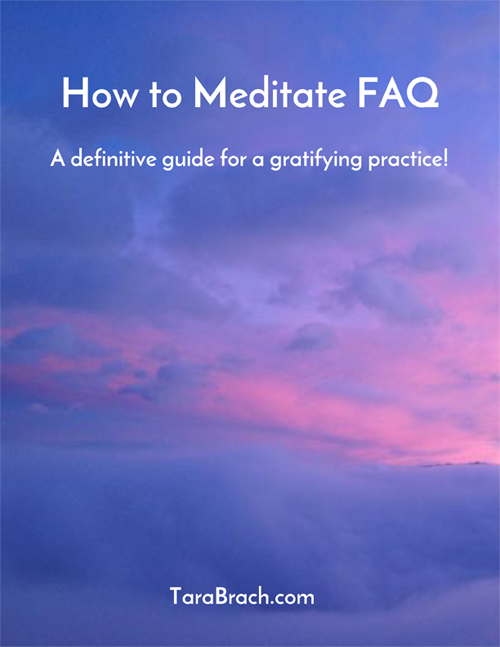Guidelines: Introducing Meditation Practices to Psychotherapy Clients
~ Tara Brach
Meditation practices increase mindfulness and openheartedness in daily life. They can also facilitate bringing difficult experiences into awareness and re-processing, i.e., re-experiencing “stuck” emotions with a healing and wise presence. For a basic introduction to the mindfulness meditation practices that inform these guidelines, please see How to Meditate and How to Meditate FAQ.
Prerequisites for therapists:
Your capacity to guide your clients in meditation is based on your own depth of practice. This grows through:
- Retreats and daily practice (formal and informal); guidance from experienced teachers
- Mindfulness practice during therapy sessions: Embodied awareness, physical anchor, noting thinking, meeting inner discomfort with yes/kindness
- Heart practices during therapy sessions. Look to see vulnerability and goodness in clients.
Tools that support clients in formal practice (arriving, quieting the mind and collecting the attention):
- Set aspiration for each meditation (presence, openheartedness, etc.)
- Identify what anchor/home base works (e.g., breath; body; sounds; words)
- Practice recognizing thoughts and returning to primary anchor
- Use primary anchor to concentrate attention. Collect and settle mind, deepen stability and presence.
Basic elements in practice of mindfulness: Recognition (direct contact) and Allowing (accepting)
- Developing capacity for recognition: (Emphasize when dissociated.)
- Embodied Awareness, senses awake: Body scan, yoga, mindful walking, listening
- Noting or naming what is noticed
- Inquiry: “What is asking for attention/acceptance?” Pay particular attention to throat, chest, belly.
- Invitation: “Let it be as big as it is…”
- Feel predominant experience directly as sensations in the body. Breathe with experience – focusing on either the center of intensity or full area. Notice how experience changes.
- Developing capacity to “allow” by widening the field: (Emphasize when flooded, possessed.)
- Say “Yes,” or “I consent,” or some other word(s) that communicates acceptance
- Attention to sound; relax body (especially hands, eyes); smile
- Let difficult energy ‘float in awareness.’ Attention to space around pain or unpleasant sensation. Attention to neutral or pleasant sensations in other parts of the body. Attention to sounds. Attention to what is seen in surrounding area.
Practices and reflections for awakening the heart:
- Loving kindness: Seeing goodness and offering care (words, images, touch)
- Compassion: Seeing vulnerability and offering care (words, images, touch)
- Forgiveness: Seeing vulnerability and offering forgiveness
- Safe container/refuge: Discover what person, place, spiritual ally or archetype is an expression of wisdom and compassion (i.e., the beloved or divine) and develop pathway or internal sensory anchors for invoking (images, words, feelings, gesture or body posture). Draw on client’s past experience, religious/spiritual affiliations in identifying a refuge.
Applying mindfulness to difficult emotions – RAIN:
R – Recognize what is going on
A – Allow the experience to be there, just as it is
I – Investigate with interest and care
N – Nourish with self-compassion
NOTE: for in-depth explanation and guided meditation, see The RAIN of Self-Compassion
Informal practices:
Pausing, noting through day, embodied presence, using anchor when distracted, heart practices whenever inclined, remembering aspiration whenever possible.
Trauma guidelines:
Download a Free Meditation Practice Guide to Working with Trauma & PTSD
- Safe refuge: Develop reliable internal anchor for safety; develop safety/trust in therapeutic relationship.
- Grounding: Bring attention to feeling of pressure/warmth where bottom contacts chair, where feet contact ground; feel gravity and connection with earth.
- Draw on heart meditations in deepening sense of safety.
- When anchors and sense of safe refuge have been established, practice with difficult emotions by intentionally recognizing & allowing (being with) during therapy sessions, but not alone outside session until you deem your client is ready. Affect tolerance develops in a gradual way and it is important to avoid re-traumatizing.
- Home practice: Experiment to see what feels safe and healthy. Explore short sittings with silent practice using safety anchor to quiet mind and relax. Possibly include readings, prayers, CD’s with guided meditations. Create environment of peace, beauty, inspiration. Set aspiration regularly.
Functioning as both therapist and meditation guide:
Introducing meditation tools can be shame inducing for some clients (e.g., “Meditating is important to Tara, I can’t get myself to do it every day, I don’t do it right.”). This is a challenge in recommending any technique. It is fine to have your clients work with another meditation teacher and explore with you how to integrate the techniques into your therapy process or, if you feel it’s appropriate, offer instructions and guidance yourself. If you do:
- Frame as experiment as to what best serves healing and awakening. Client collaborates in designing a daily practice (e., explore together what anchor might work, how long to practice, whether noting is helpful, use of heart meditations.)
- Make sure that your client has clear and simple guidelines to follow for home practice. Encourage meditation classes if available and appropriate.
- Discuss how easily meditation can become a domain of judgment. Include self disclosure about your challenges in practice (striving, judging how it’s going).
- Attitude is key – approach meditation with a relaxed, interested, friendly attention. Remind your client that meditation is not another grim “to do.” It is a pathway for living and loving fully.
For more information regarding Tara Brach and her teaching schedule, please visit her website.
Meditation and Psychotherapy: Online Video Course for Integrating Mindfulness into Clinical Practice
Guided meditations: www.tarabrach.com/guided-meditations/
Talks in audio and video: www.tarabrach.com/talks-audio-video/
Books and CDs: www.tarabrach.com/store/
Facebook: www.facebook.com/tarabrach
Instagram: @tarabrach


